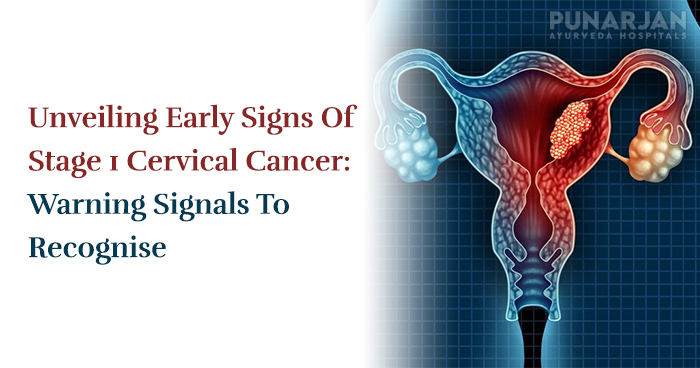
Cancer gets its name from where it begins, even if it moves to other parts later. When it starts in the cervix, it’s called cervical cancer. The cervix connects the vagina to the top of the uterus. A baby grows here during pregnancy.
Anyone with a cervix can be at risk for cervical cancer, especially those over 30. The main reason for cervical cancer is a persistent infection with human papillomavirus (HPV).
Stage 1 cervical cancer means the disease has spread only in the womb’s neck. The primary treatment option for stage 1 is surgery. Chemotherapy and radiation are rarely included in a combined treatment.
Read ahead to learn about stage 1 cervical cancer symptoms, diagnosis, risk factors, treatment, and more.
Stage 1 Cervical Cancer Symptoms
Cervical cancer stage 1 can be divided further into two categories – stage 1A and stage 1B.
- The cell growth is small in stage 1A. It can be seen with a microscope. The cells grow from 3mm to 5mm in the cervical tissues.
- The cells expand in stage 1B and grow more than 5mm. They can grow up to 4cm or bigger and are visible without a microscope.
In its early stages, cervical cancer often remains asymptomatic, posing challenges for early detection. Symptoms typically manifest once the cancer has spread.
Stage 1 cervical cancer symptoms may include:
- Bleeding from the vagina following sexual intercourse
- Vaginal bleeding post-menopause
- Abnormal vaginal bleeding between menstrual cycles or experiencing unusually heavy or prolonged periods
- Vaginal discharge characterised by a strong odour, watery consistency, or containing blood
- Pelvic discomfort or pain during sexual intercourse
Other Common Warning Signs and Symptoms
Symptoms indicating advanced cervical cancer (where the cancer has metastasised beyond the cervix) may include those observed in early-stage cervical cancer, along with:
- Difficulty or pain during bowel movements or rectal bleeding
- Painful or challenging urination or the presence of blood in the urine
- Persistent backache
- Swelling of the legs
- Abdominal pain
- Fatigue
It’s important to note that these symptoms could arise from various other conditions besides cervical cancer. Consulting a healthcare provider is crucial for accurate diagnosis and treatment.
Gynaecological Examinations and Pap Smears
A routine gynaecological examination is an excellent way to protect your health. The doctor provides necessary vaccinations, performs screenings, or advises on overall health. A pelvic examination involves screening the cervix and vagina. It takes about 15 to 20 minutes and helps prevent future issues.
Pap smears or Pap tests check your cervix. The cervix is the narrow end of the uterus linked to the vagina. They help find unusual cells, infections like HPV, and early signs of cervical cancer.
In a Pap smear, a healthcare professional puts a small spatula or brush into your vagina to collect cervical cells. It might cause slight discomfort. The collected sample is examined in a lab for HPV and abnormal cells.
Human Papillomavirus (HPV) and Cervical Cancer Risk
The human papillomavirus (HPV) is a key risk factor for cervical cancer. Many people get HPV, especially for those who are sexually active. The virus doesn’t cause any harm and goes away by itself in most.
HPV has many types, and most of them don’t do any harm. Some types can cause genital warts. You can get HPV through close skin-to-skin contact, usually during sex.
There are about 14 types of HPV that are considered high risk for cervical cancer. Two of these types are HPV 16 and HPV 18. They are responsible for about 70 out of 100 cases of cervical cancer.
The immune system usually clears about half of HPV infections within 6 to 12 months. But sometimes it doesn’t go away. If you have a persistent infection, you’re at a higher risk of developing cervical cancer.
Risk Factors And Predisposing Conditions
Factors increasing the chances of cervical cancer are as follows:
- Smoking raises the risk of cervical cancer and reduces the likelihood of HPV clearing from the body.
- Having sex at a young age increases infection risk.
- Engaging in sexual activities with more than one partner puts you at a higher risk.
- A weak immune system may not eliminate the HPV infection on its own.
- Women with a sexually transmitted infection (STI), in addition to HPV, may face an increased risk of cervical cancer.
Coping With Emotional Challenges
Receiving news about cervical cancer can be tough. It might be hard to accept and understand what might happen next. But it’s important to learn that you’re not alone. Some people have experienced similar emotions.
A key thing to do is recognise and accept your feelings. Feeling scared, anxious, sad, or upset is okay. Don’t be too hard on yourself. Talking to someone you trust, like a friend, family member, or therapist, is recommended. It helps you stable your emotions and find healthy ways to deal with them.
Taking care of yourself is also essential. Eat healthy, stay active with regular exercise, and get enough sleep. Don’t isolate yourself; stay connected with people who care about you. Having supportive friends and family around can help you feel better emotionally.
Treatment Options For Stage 1 Cervical Cancer
The cancer stage plays a significant role in determining an appropriate treatment plan. The location of the cancer and other healthy conditions are also crucial.
Stage 1 cervical cancer symptoms can be treated with:
- Cone biopsy or surgery
- Combined radiation therapy and chemotherapy
For early-stage 1A1 cancers, doctors often remove all the cancer by using procedures such as cone biopsy or a large loop excision of the transformation zone (LLETZ). These procedures are also used for women with abnormal cervical cells detected during cervical screening. If you no longer wish to have children or preserving fertility isn’t a concern, a straightforward treatment option might be a hysterectomy. This involves removing the following:
- Cervix
- Womb
- Fallopian tubes
Do you want to keep the possibility of having children but still have stage 1 cervical cancer symptoms? Your doctor might suggest one of these treatments for stage 1A2 cancer:
- Cone biopsy
- Removing only the cervix (simple trachelectomy)
- Removing the cervix, tissue around it, and the upper part of the vagina (radical trachelectomy)
One might get chemoradiotherapy if:
- Cancer cells are found in your lymph nodes or the tissues around your cervix.
- Cancer cells are present at the tumour’s edges (positive margins).
- There’s a significant invasion of lymphovascular space.
- Your tumour is larger than 4cm.
Preventive Measures And Lifestyle Choices
Cervical cancer can be prevented and cured if stage 1 cervical cancer symptoms are detected early. Here are some preventive measures –
- Most cervical cancers can be prevented with the HPV vaccine. It is a safe and effective way to reduce cervical cancer risk.
- Condoms are beneficial in preventing sexually transmitted diseases. It decreases HPV and other infection risks.
- Getting screened at regular intervals is another preventive measure. HPV and cytology tests are widely used screening methods.
How Does Punarjan Ayurveda Help Fight Cervical Cancer?
Punarjan Ayurveda has a special way of helping with cervical cancer. We mix traditional wisdom with modern ideas to create a complete approach. The aim is to support women by giving caring treatment and effective therapies.
We understand how tough it is for a woman with cervical cancer, both mentally and physically. Our team works hard to make personalised treatment plans that fit each patient’s needs. Ayurvedic medicines, cleansing methods, immune-boosting techniques, and dietary changes promote natural healing.
Punarjan Ayurveda is a way that cares about your health with Ayurveda. Let’s join forces to fight cervical cancer with determination, hope, and healing.
Here are some ways used to treat the condition –
- Strengthens Ojas : We begin by enhancing Ojas, the ultimate health shield in Ayurveda. Natural compounds from the earth, like Swarna Bhasma, strengthen your body’s natural defences.
- Removing Toxins : Detox treatments remove harmful substances in your body that make tumours grow. This helps bring back a healthy environment inside your body.
- Dosha Balance – We work on balancing Ayurvedic doshas: Vata, Pitta, and Kapha. When these doshas are out of balance, it can lead to diseases.
- Ayurvedic Therapies : Treatments like Vamana (using medicine to induce vomiting) and Raktamokshana (removing a small amount of blood) eliminate harmful substances. This prevents the buildup of chemicals that could cause mutations.
Conclusion
Recognising the early signs of stage 1 cervical cancer is crucial for timely intervention. By being vigilant about stage 1 cervical cancer symptoms and other warning signals, individuals can seek medical attention promptly. Regular screenings, open communication with healthcare providers, and awareness play pivotal roles.
Empowering individuals with knowledge about stage 1 cervical cancer symptoms and signs can contribute to early diagnosis. It facilitates more effective treatment options. Regular check-ups and a proactive approach to gynaecological health are key to addressing stage 1 cervical cancer.
We at Punarjan Ayurveda offer a holistic approach to cervical cancer treatment, focusing on strengthening the body’s natural defenses, detoxification, and restoring dosha balance through personalised Ayurvedic therapies. With determination, hope, and healing, together, we can combat cervical cancer and promote overall well-being.
FAQs
Is Cervical Cancer Curable At Stage 1?
Cervical cancer stage 1 is curable for most patients. Around 92% of women with localised cervical cancer will be alive after 5 years of diagnosis.
Is Cervical Cancer Painful?
Cervical cancer itself typically isn’t painful in its early stages. However, as the cancer progresses, it may cause discomfort or pain, especially if it spreads to nearby tissues or organs. Pain can also occur if there are complications or side effects from treatment.
What Is The Best Cure For Cervical Cancer?
The best cure for cervical cancer depends on the stage and extent of the disease. Treatments may include surgery, radiation therapy, chemotherapy, or a combination of these. Early detection and personalised treatment plans offer the best chance of cure and long-term survival.
Does Cervical Cancer Stop Periods?
While cervical cancer does not stop periods, it may result in unusual periods. Stage 1 cervical cancer symptoms include unusual vaginal bleeding, bleeding after sex, abnormal bleeding between periods, etc.
What Is The Importance Of Regular Gynecological Check-Ups?
Regular gynaecological check-ups are important for the early detection of cervical cancer and other reproductive health issues. They help in monitoring overall gynecological health, ensuring timely interventions, and promoting preventive care.
What Are The Factors Increasing The Risk Of Cervical Cancer?
Factors increasing the risk of cervical cancer include persistent HPV infection, smoking, weakened immune system, early sexual activity, multiple sexual partners, and a history of sexually transmitted infections.


